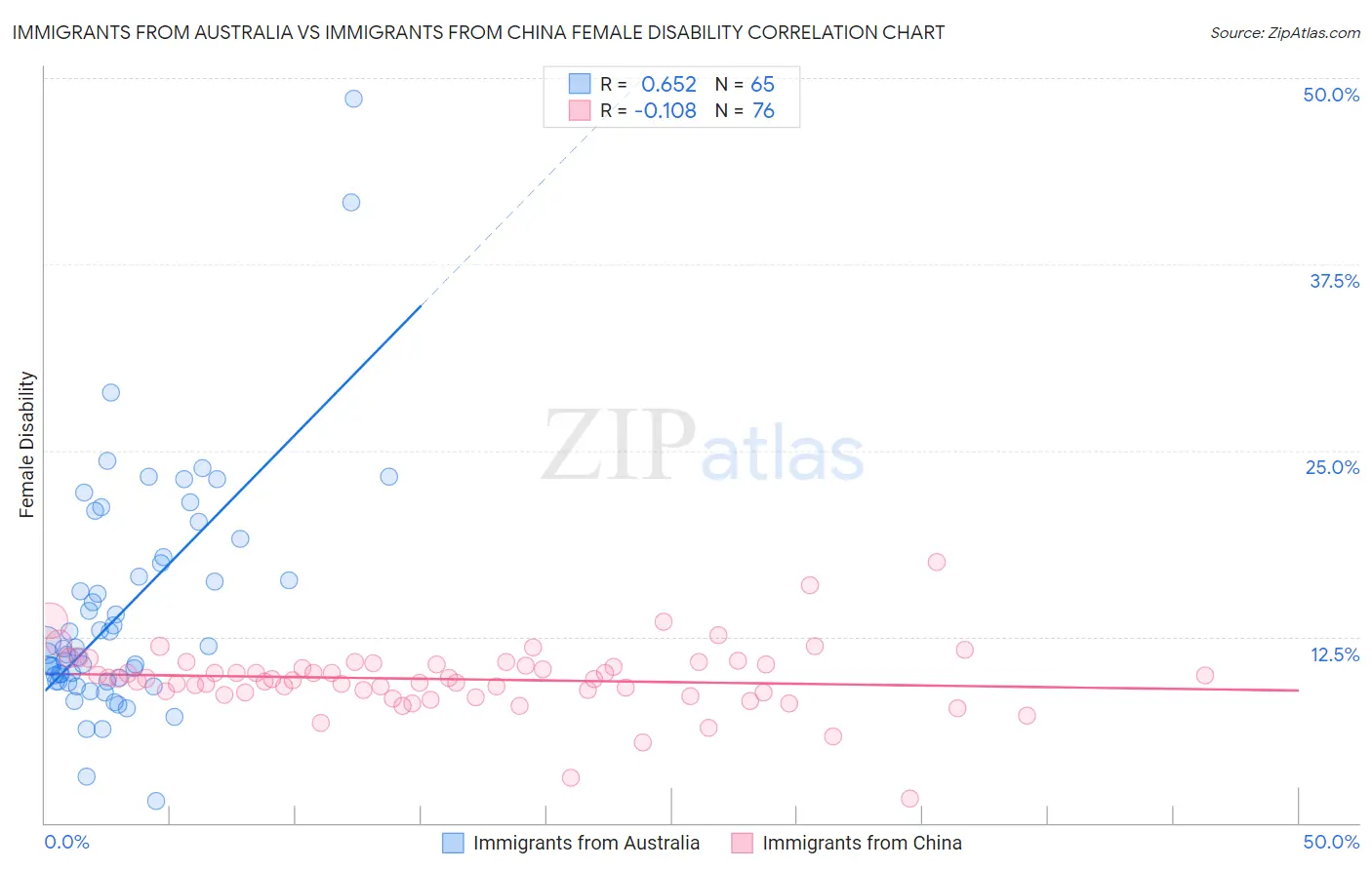Immigrants from Australia vs Immigrants from China Female Disability
COMPARE
Immigrants from Australia
Immigrants from China
Female Disability
Female Disability Comparison
Immigrants from Australia
Immigrants from China
11.1%
FEMALE DISABILITY
100.0/ 100
METRIC RATING
32nd/ 347
METRIC RANK
10.7%
FEMALE DISABILITY
100.0/ 100
METRIC RATING
14th/ 347
METRIC RANK
Immigrants from Australia vs Immigrants from China Female Disability Correlation Chart
The statistical analysis conducted on geographies consisting of 227,197,779 people shows a significant positive correlation between the proportion of Immigrants from Australia and percentage of females with a disability in the United States with a correlation coefficient (R) of 0.652 and weighted average of 11.1%. Similarly, the statistical analysis conducted on geographies consisting of 457,020,371 people shows a poor negative correlation between the proportion of Immigrants from China and percentage of females with a disability in the United States with a correlation coefficient (R) of -0.108 and weighted average of 10.7%, a difference of 4.1%.

Female Disability Correlation Summary
| Measurement | Immigrants from Australia | Immigrants from China |
| Minimum | 1.4% | 1.6% |
| Maximum | 48.6% | 17.5% |
| Range | 47.1% | 15.9% |
| Mean | 14.3% | 9.6% |
| Median | 11.7% | 9.7% |
| Interquartile 25% (IQ1) | 9.5% | 8.8% |
| Interquartile 75% (IQ3) | 17.7% | 10.7% |
| Interquartile Range (IQR) | 8.1% | 1.9% |
| Standard Deviation (Sample) | 7.9% | 2.3% |
| Standard Deviation (Population) | 7.9% | 2.2% |
Demographics Similar to Immigrants from Australia and Immigrants from China by Female Disability
In terms of female disability, the demographic groups most similar to Immigrants from Australia are Immigrants from Egypt (11.1%, a difference of 0.080%), Immigrants from Kuwait (11.1%, a difference of 0.17%), Immigrants from Malaysia (11.1%, a difference of 0.27%), Turkish (11.1%, a difference of 0.27%), and Egyptian (11.1%, a difference of 0.33%). Similarly, the demographic groups most similar to Immigrants from China are Immigrants from Eastern Asia (10.7%, a difference of 0.040%), Burmese (10.7%, a difference of 0.51%), Okinawan (10.8%, a difference of 0.58%), Indian (Asian) (10.8%, a difference of 0.90%), and Immigrants from Iran (10.8%, a difference of 1.3%).
| Demographics | Rating | Rank | Female Disability |
| Immigrants | Eastern Asia | 100.0 /100 | #13 | Exceptional 10.7% |
| Immigrants | China | 100.0 /100 | #14 | Exceptional 10.7% |
| Burmese | 100.0 /100 | #15 | Exceptional 10.7% |
| Okinawans | 100.0 /100 | #16 | Exceptional 10.8% |
| Indians (Asian) | 100.0 /100 | #17 | Exceptional 10.8% |
| Immigrants | Iran | 100.0 /100 | #18 | Exceptional 10.8% |
| Immigrants | Venezuela | 100.0 /100 | #19 | Exceptional 10.9% |
| Immigrants | Pakistan | 100.0 /100 | #20 | Exceptional 10.9% |
| Asians | 100.0 /100 | #21 | Exceptional 10.9% |
| Immigrants | Sri Lanka | 100.0 /100 | #22 | Exceptional 10.9% |
| Venezuelans | 100.0 /100 | #23 | Exceptional 11.0% |
| Immigrants | Argentina | 100.0 /100 | #24 | Exceptional 11.0% |
| Immigrants | Asia | 100.0 /100 | #25 | Exceptional 11.0% |
| Argentineans | 100.0 /100 | #26 | Exceptional 11.0% |
| Immigrants | Turkey | 100.0 /100 | #27 | Exceptional 11.1% |
| Egyptians | 100.0 /100 | #28 | Exceptional 11.1% |
| Immigrants | Malaysia | 100.0 /100 | #29 | Exceptional 11.1% |
| Turks | 100.0 /100 | #30 | Exceptional 11.1% |
| Immigrants | Kuwait | 100.0 /100 | #31 | Exceptional 11.1% |
| Immigrants | Australia | 100.0 /100 | #32 | Exceptional 11.1% |
| Immigrants | Egypt | 100.0 /100 | #33 | Exceptional 11.1% |